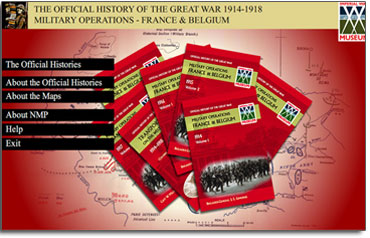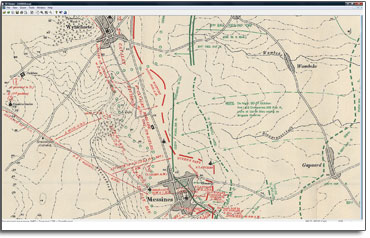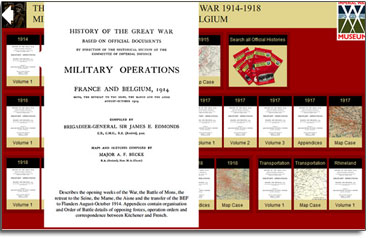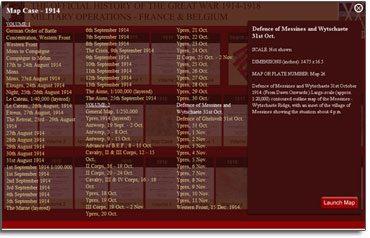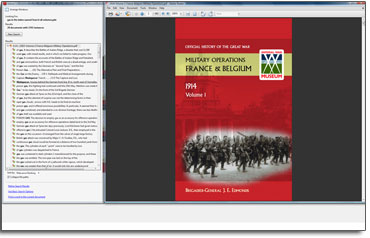
 Official History of
Official History of
The Great War DVD-ROM
Military Operations France & Belgium
Transportation on The Western Front &
occupation of the Rhineland
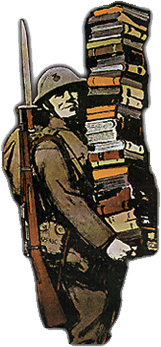 Historical Overview of the Histories
Historical Overview of the Histories
by Colonel Terry Cave The man responsible for this tremendous piece of work was Brig-Gen J.E Edmonds, who was born in 1861 and was commissioned into the Royal Engineers in 1881.When war broke out he was a colonel, GSO1 of the 4th Division, but within a few days of arrival in France, during which time the division fought at le Cateau and began its retreat to the Marne, Edmonds was found to be medically unfit for front line soldiering and was posted back to HQ BEF where, by the end of the war, he was one of the two Deputy Engineer-in-Chiefs. In 1919 he took over as OIC Military Branch, Historical Section Committee of Imperial Defence where he stayed for the next thirty years. He died in 1956 at the ripe old age of 95.
He needed a “ripe old age” because it took nearly thirty years for all the volumes of his meticulously prepared history to see the light of day. The first volume, 1914/I,was published in 1922 and then there was a delay while the section with its thousands of boxes of records and maps was re-located resulting in a belated publication of the second 1914 volume in 1925. By 1932 the two 1915s and the first 1916 were out and then the run fell out of sequence. For some time, to speed things up, preliminary work on 1916 and1918 had been going on simultaneously but this arrangement came to an end when there was a reduction in staff for reasons of economy at a time when the 1918 drafts were in a more advanced state than 1916/II. Given the particular interest in the story of the German March 1918 offensive it was decided to publish the first two 1918 volumes dealing with those events as a priority, and they came out in 1935 and 1937. 1916/II (by Capt W. Miles) followed in 1938 and I918/III in 1939.The first of the three 1917 volumes appeared in 1940 but the preparations of next two as well as the last two of the five 1918 volumes suffered from reductions in staff following the outbreak of WWII.They came out eventually in 1947 and 1948 respectively.
The real fly in the ointment was the volume dealing with the occupation of the Rhineland. It was started back in 1930 but then the Treasury refused to sanction it and Treasury economy continued to hamper the activities of the Historical Section. Edmonds ploughed on regardless and the first draft was ready in 1943, to be met with objections and criticism from the Foreign Office whose remarks he described as trifling or silly and which he proposed to ignore. He claimed that the views expressed in his account were his own and not official, which is stated in the preface, and in spite of his objections the decision was taken to produce only a limited edition of 100 copies, at the price of accommodating many of the FO’s demands, printed for ‘Official use’ only; this came out at the end of 1947.
In the Introduction to the first volume (1914 vol I) Edmonds stated his aim: “This history has been compiled with the purpose of providing within reasonable compass an authoritative account, suitable for general readers and for students at military schools, of the operations of the British Army in the Western theatre of war in 1914 -1918”. In this he has certainly succeeded , for today, if anyone wants to know about and understand the British Army of the Great War, its tactics, its battles, changes in organisation, weapons and its development from a small professional force in 1914 to the mighty force of five armies in 1916, this history is essential reading.
With a history as long and as detailed as this there were bound to be detractors and critics, one of the principal objections being that he was too keen on protecting the reputations of Haig and senior commanders. In the preface to the volume dealing with Passchendaele (1917 II), for example, Edmonds notes the damage done to Haig’s reputation by that battle and mounts a vigorous defence of the Field Marshal, stating, inter alia, that “the principal items in the indictment against Earl Haig in legend depend on gross exaggeration of the British casualties and on the misrepresentation that the whole area of the battlefield was a morass…..” He goes on to point out that, in contrast, Haig’s reputation in Germany, France and the USA “stands high.” Military history is indebted to Brigadier General Edmonds whose stubborn determination saw this great project through to the finish and it remains his testimony. “Without Edmonds’ devotion, the official history would never have been completed. It remains an essential text for anyone wishing to understand the British army during the Great War” Dr J Bourne Who’s Who In World War One.
“This history has been compiled with the purpose of providing within reasonable compass an authoritative account, suitable for general readers and for students at military schools, of the operations of the British Army in the Western theatre of war in 1914-1918. It is based on the British official records.” Brig-Gen J.E Edmonds.
The Official History of the Great War was the grandest official history ever produced in Britain. Due to the number of full-colour maps bound in each volume and the separate map cases, previous attempts to reprint in its complete entirety this valuable reference ether floundered, or were produced with the maps in monochrome.
At last the acclaimed work of the official cartographers, who had ninety thousand maps at their command can be examined as they intended in full colour.
| Copyright ©2010 Naval & Military Press Ltd | |
